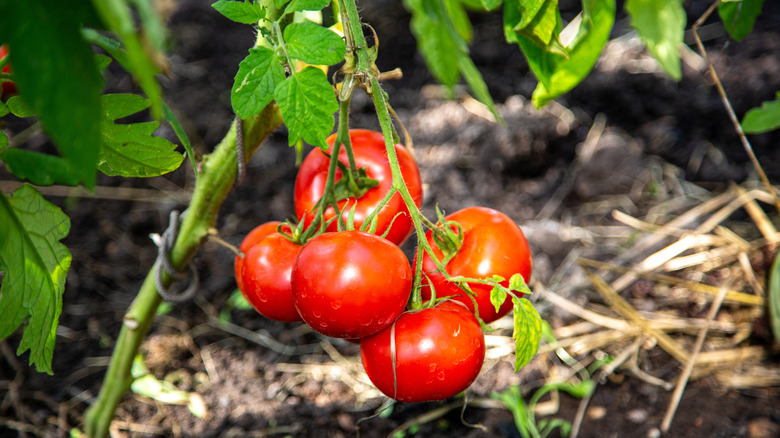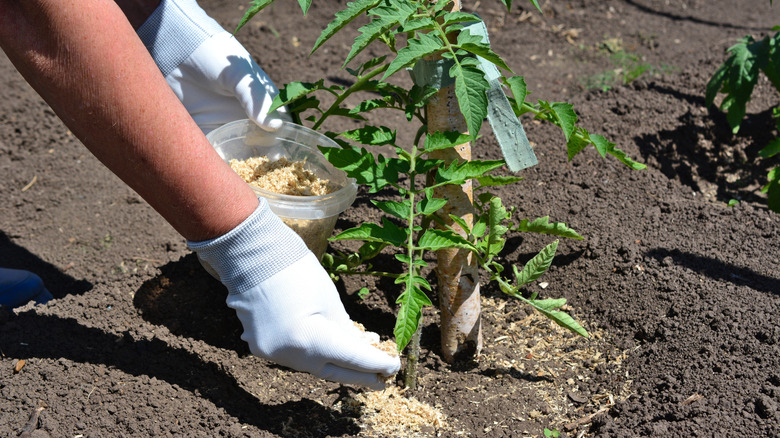The Simple Soil Addition That Is A Total Game-Changer For Tomato Gardens
We may receive a commission on purchases made from links.
For tomato lovers, there is nothing more delicious than a plump, home-grown tomato. Forget the ones in the upscale urban grocery stores that gloat about being organically cultivated in greenhouses made entirely from recycled bicycle seats. Those tomatoes are flavorless compared to the ones you grow in a pot of dirt on your patio or a patch of soil you tilled in a sunny corner of your backyard. That perfectly ripe fruit plucked fresh off the vine on a hot August day is so scrumptious, you'll want this year to be a bumper crop. What you need is a simple soil addition that is a total game-changer for tomato gardens, one that ensures the right nutrients to make your tomato plants prolific and their fruit sweet and juicy. The soil additive making those lofty claims is none other than bone meal. Sure, you could try a bizarre trick that is the secret to growing big, juicy tomatoes (hint: it's something fishy), but bone meal is readily available at any garden center.
Bone meal is a granular fertilizer created from crushed animal bones that clocks in with about 24% calcium and 20% phosphorus. It's a powerhouse of macronutrients when used the right way and under the right soil conditions. Test your soil before planting by using something like the Luster Leaf 1601 Rapitest Soil Test Kit to ascertain what your soil needs. When it comes to growing delicious tomatoes, you'll generally need soil that has a pH level in a range that's only slightly acidic or the low end of neutral (approximately 6.0 to 6.8), but it's bone meal's phosphorus that the tomatoes crave.
Phosphorus-boosting bone meal gives tomatoes an extra push
If bone meal sounds familiar, it might be because a lot of people are accustomed to including it when planting fall bulbs. Although if you're still doing that, one of the essential tips for protecting fall daffodil bulbs is to stop incorporating bone meal since it may attract hungry rodents who munch on your bulbs. Remember, it's the source of bone meal — crushed animal bones — that lures unwanted critters and pests unless it's applied at least a few inches deep and worked into the soil. That can be tricky to do once your plants have put down roots. If you're careful not to disturb the roots, you should still be able to work the grains two inches below the top of the soil. It will feed your plants slowly over the course of several months.
Tomato plants have gained a reputation for having a big appetite in the gardening world. That's why some gardeners like to put bone meal on the plant's metaphorical menu. You'll want to take a tip from one of the 18 handiest hacks to remember when growing tomatoes and add extra phosphorus once the tomatoes get going. Bone meal has a heaping helping of phosphorus to share with the tomatoes, and that element is necessary to help the plant generate healthier blooms. And remember: No blossoms, no tomatoes! Especially a little later in the growing season, you may determine that your tomatoes are one of the plants that need extra fertilizer in August for long-lasting blooms, and bone meal may be able to give them what they need to keep flowering.
Bone meal isn't without its downsides
Bone meal has the potential to be a game changer when used as a phosphorus booster for tomatoes. As with any products, it's a good idea to remember to follow any directions listed on the packaging. Bone meal is no exception even if it is made from natural materials. It also isn't universally loved by garden experts. Though it's common and has been in use for a long time, gardeners should weigh the concerns and disadvantages to determine if they're comfortable using it in their gardens. Already noted was the potential for bone meal to attract critters, which could include squirrels, raccoons, skunks, or even your own dog who may want to do some digging to see if there's a bone he can play with that's hiding under your tomato plants.
Never forget to test your soil every time you want to add some bone meal. If you add it indiscriminately when it isn't needed, you could unintentionally alter the balance of the soil, including the useful germs and microbes, causing more harm than good. The opposite end of that spectrum is that if the soil surrounding your tomatoes seems to need a fast fix, you may want to think twice about using bone meal. It's a slow-release fertilizer that takes its time getting phosphorus into the soil, often needing weeks to get to work. Finally, two cautions for humans. First, protect yourself from inhaling the bone meal dust by wearing protective goggles and a mask. Secondly, if you're trying to grow your tomatoes in a vegan environment, skip the bone meal since it's sourced from animal bones.

